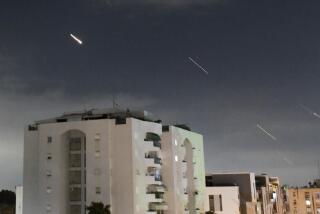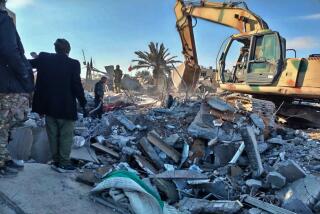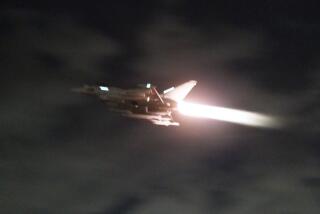Speed, Deception Planned to Crush a Crippled Enemy : Offensive: Multiple attacks will force the Iraqis to defend at numerous points and mask ‘the hammer.’
- Share via
WASHINGTON — The massive U.S.-led ground assault against the Iraqi army will be a campaign of speed and deception, a seamless maneuver designed to crush a crippled adversary, senior Pentagon officials said Saturday.
The offensive, which envisions simultaneous air, land and amphibious attacks across the entire front, contains no intermediate objectives or “fire breaks” where action would pause to allow an orderly Iraqi withdrawal.
The multiple attacks will force the Iraqis to defend at numerous points and will mask the main assault, a 150,000-man armored and airborne attack, which Pentagon officials call “the hammer.”
The attack will not stop until the hammer has fallen on the entire Iraqi field army, officials said.
A senior Army official said Saturday that Iraqi troops will soon face the alternatives--”They will either die in place or surrender.”
Senior Pentagon officials were confident, even cocky Saturday. Officials with access to the war plan and current intelligence predict that the ground assault could be completed in as few as 14 days. They said it could claim fewer than 1,000 U.S. casualties.
But nagging concerns remain. Officials warned Saturday that the Iraqis retain 1,500 artillery pieces and unknown stores of chemical weapons that desperate Iraqi troops could fire at allied ground troops advancing into planned “killing zones.”
While that is one of the “dirtiest tricks” that Iraqi forces could use to thwart allied forces, it is only one of several that Iraq could use to forestall defeat. Military commanders fear that the Iraqis may be readying their remaining combat aircraft for kamikaze strikes against allied troops or against Israel.
While Iraqi aircraft have not flown for several days, intelligence analysts have spotted maintenance work being done on some of the remaining warplanes, and most of Iraq’s most skilled pilots remain in Iraq. During the Iran-Iraq War, Iraqi warplanes sprayed poison gas over the battlefield from aircraft, officials noted.
Military commanders also are fretting that Iraqi leaders could discern the direction of the main allied assault and move reinforcements into place to blunt the attack.
But the allied ground campaign is designed to leave Iraqi commanders with little understanding of where allied forces are moving and what their objectives are.
As the allies advance in different directions, they will “peel off” troops to hold Iraqi units in place and use the speed of helicopters, M-1 tanks and airborne forces to outflank, outrun and confuse slow-moving Iraq forces.
“We will be throwing sand in his eyes while we’re hitting him in the side and blaring rock music from a loudspeaker while a dog is nipping at his ankles. We want him to believe that a human wave is descending upon him,” said a knowledgeable Pentagon official.
One senior defense official familiar with the details of the battle plan said that the rapid and fluid movements are designed “to get inside the turning radius” of the Iraqi military, devising counters to the Iraqis’ reactions even before they have executed them.
Many Iraqi units have been made virtually immobile and unable to communicate with each other or higher commands by five weeks of aerial bombardment, officials said.
Intelligence analysts have concluded from the Iraqis’ performance Jan. 30 at Khafji that coordination among Iraqi military units is crucial to their combat performance.
“Right now, the momentum is with us. Keeping the situation moving faster than they can react to it is key,” said the official.
Highly mobile U.S. forces, such as they 101st Air Assault Division, may be one of the keys to the allies’ deceptive tactics, officials suggested. Using helicopters to move troops and heavy weapons hundreds of miles in a matter of hours, the 101st can “leapfrog” deep into Iraqi territory, feinting toward one direction, then suddenly shifting to another once they have drawn Iraqi troops out to meet them.
Similarly, some of the 18,000 Marines afloat off the Kuwaiti coast could be sent ashore to deceive the Iraqis, forcing them to commit troops held in reserve in the heart of Kuwait. Meanwhile, the bulk of the amphibious force could land elsewhere or a more powerful armored force could move in from the rear of the Iraqi reserves and cut them off, a military official said.
Other Iraqi units would be passed by swiftly moving allied ground units, which would leave combat forces behind to “fix” the Iraqi units in place. And paratroopers of the 82nd Airborne could be dropped into positions that mask the movement of the major thrust.
“Fixed fortifications and pillboxes can be bypassed, and smart leaders would look at that very hard,” said Lt. Gen. Thomas W. Kelly, director of operations of the Joint Chiefs of Staff.
But the U.S.-led offensive’s reliance on speed, maneuver and deception could allow some allied units to be drawn into a chemical weapons trap, a senior military official said. He added that wind conditions are favorable for the Iraqi use of poison gas, blowing generally from Iraqi positions toward attacking allied units.
The only militarily effective way to deliver chemical weapons is to air drop them or concentrate the weapons on a predetermined spot with an artillery barrage using a large number of big guns, an Army official said. U.S. commanders in Saudi Arabia fear that the Iraqis have created such deadly zones along expected allied avenues of attack, he said.
Allied troops have showered Iraqi forces with leaflets in recent weeks warning them that soldiers who carry out orders to launch chemical weapons will be subject to international law forbidding their use.
On Saturday, Kelly repeated that warning, saying that Iraqi troops “need to reflect in some depth on the wisdom of using chemical weapons against us, because we will not take that lightly, and they will be held responsible for it, whether it’s on a field of battle or later.”
Officials said the Iraqi military, with at least 39% of its tanks and 48% of its artillery destroyed by aerial bombardment, has been battered but remains capable of putting up a fight.
The elite Republican Guard, sitting just north of the Iraq-Kuwait border, is still considered an effective force and the armored “theater reserve” forces encamped in central Kuwait also pose a continuing threat, officials said.
The two forces are “least hurt and most effective” and probably “will fight until they die,” a knowledgeable military official said. Most of them are commanded by veterans of the eight-year Iran-Iraq War.
More to Read
Sign up for Essential California
The most important California stories and recommendations in your inbox every morning.
You may occasionally receive promotional content from the Los Angeles Times.











